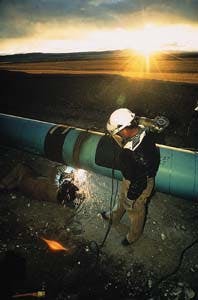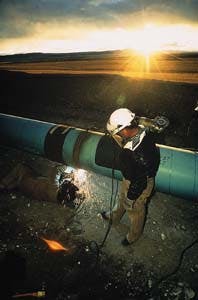Robert J. Hewitt
Kenneth D. Miller
Blake T. Eskew
Steven J. Kelly
Purvin & Gertz Inc.
- U.S. Crude Oil Production Outlook [39419 bytes]
- U.S. Oil Supply, Imports [22766 bytes]
- U.S. Inland Oil Imports [23247 bytes]
- PADD III Crude Oil Production [ bytes]
- Midcontinent/Gulf Price Spread Volatility [19257 bytes]
- Outlook for Inland Gulf Price Spread [18868 bytes]
- Crude Imports for PADDS II and IV [ bytes]
- Canadian Crude Balance [ bytes]
- PADD II Crude Oil Balance [ bytes]
- PADD IV Crude Oil Production [ bytes]
Welders capitalize on daylight to connect a joint of the 785-mile, 24-in. Express Pipeline. Such projects are increasing to deliver more imported crude to U.S. inland refineries as oil production in those regions declines. Photo courtesy Express Pipeline.
Editor's note: This article summarizes a study Purvin & Gertz conducted exclusively for Oil & Gas Journal and updates lead news stories in the Dec. 24, 1990, and Nov. 21, 1994, issues of OGJ.
Crude oil supply patterns for refiners in the U.S. Midwest and Rocky Mountain regions are in a state of transition as regional crude oil production continues to decline rapidly.
Inland refiners in the Petroleum Allocation Defense Districts (PADDs) II and IV are becoming increasingly dependent on deliveries of imported crude, especially from Canada.
A number of pipeline projects are under way to deliver increased import volumes from both Canada and "offshore" sources (tankerborne imports landed at U.S. coasts), to forestall any regional shortfalls.
However, as new refinery supply patterns emerge, crude price relationships among the major North American markets-the Gulf Coast; Cushing, Okla.; and Edmonton, Alta.-will be continually adjusting to reflect evolving regional supply balances.
U.S. crude production
During 1985-95, U.S. crude oil production fell to 6.6 million b/d from 8.9 million b/d, an average decline rate of 3%/year.
New production from the Gulf of Mexico will arrest this decline through 2000, but by 2005, total U.S. production is projected to fall to about 6.1 million b/d.
In PADDs II and IV, crude production has fallen off more sharply. The annual decline rate has averaged 5.5%/year since 1985 and is projected to exceed 4%/ year throughout the next decade.
As a result of these dwindling local crude supplies, inland refiners satisfied just 27% of their 1995 crude needs with in-PADD production, down from more than 50% 10 years earlier.
By 2005, Purvin & Gertz projects this coverage ratio will fall to only 16%. Combined crude production in PADDs II and IV will sink to an estimated 631,000 b/d, down 63% from the 1.7 million b/d produced in 1985.
The outlook for crude oil production in PADD III is more upbeat. Spurred by improvements in seismic data interpretation and supported by rapid advances in drilling technology, production from the Gulf of Mexico is projected to almost double during the next 10 years.
This surge will more than offset continuing declines in West Texas and other mature producing areas in PADD III.
In PADD V, crude oil production is projected to decrease by 2005 to less than 1.7 million b/d, down 34% from 1995's 2.5 million b/d rate.
Policies and regulations governing exploration, production, and transportation activities in both Alaska and California will heavily influence future crude oil production in PADD V.
U.S. crude imports
By 2005, U.S. refinery runs are projected to increase by 3.5 million b/d from the 1985 level to 15.5 million b/d.
During this same period, total U.S. crude imports will have risen to 9.4 million b/d from 3.2 million b/d.
In relative terms, while refinery runs increase by 22%, crude imports must triple. Imported crude's share of total crude supply has jumped to 52% in 1995 from 27% in 1985 and will climb further to 60% by 2005.
Roughly 80% of crude oil imports are received by East Coast, Gulf Coast, and West Coast refineries.
The remaining imports satisfy the requirements of the inland refiners, with volumes split between Canadian and offshore receipts.
A dynamic balance exists between these "northern" and "southern" sources of crude imports for inland refiners, and the economic balance point will be shifting with each new change in regional crude supplies.
Canadian crude outlook
Canada's crude exports to the U.S. have risen steadily with production.
Canadian production in 1995 approached 2 million b/d, up 25% from 1985.
Essentially all of 1995 production originated in the western provinces.
Canada's demand for domestic crude is about 900,000 b/d, with refineries in the Atlantic provinces and in Quebec processing imported crudes.
Canadian crude exports to the U.S. in 1995 exceeded 1 million b/d, up by 570,000 b/d (120%) from 1985.
By 2005, total Canadian crude production may exceed 2.3 million b/d. A substantial portion of this increase will be heavy crude. In the near term, total production of Canadian heavy crude will likely be constrained by refinery process capabilities, rather than supply limits.
Pipeline expansions
In response to these increasing supplies, a number of pipeline expansion projects are under way.
Interprovincial Pipeline Company (IPL) will complete an expansion project in late 1996 that will increase delivery capability into northern PADD II by 120,000 b/d.
A new bypass connection between IPL's Westspur, Sask., system and the Portal pipeline is also part of this expansion, which allows IPL to divert as much as 50,000 b/d of crude around a capacity-limited line segment at Cromer, Man., for delivery into Clearbrook, Minn.
With production and exports expanding further, IPL has announced a Phase 2 expansion, expected to be completed in 1998, which will add another 170,000 b/d of export capacity destined for PADD II.
Several other pipeline debottlenecking projects are under way-Cenex; Amoco/Conoco; Bow River/ Milk River; and Wascana/Texaco/ Butte-that together may add 150,000-200,000 b/d of additional crude delivery capacity to PADD IV.
Express pipeline
Alberta Energy Co. Ltd. and Trans- Canada PipeLines have formed a joint venture to construct the Express pipeline from Hardisty, Alta., to Casper, Wyo. (see related story, p. 24).
Construction of the Express pipe- line will be complete by yearend. The initial capacity of this 775-mile, 24-in. pipeline will be 170,000 b/d.
Express is currently determining the level of interest in a further, 100,000 b/d expansion. At Hardisty, the pipeline could receive many crudes directly, including Hardisty light, Bow River, Lloydminster blend and synthetic crude from the Bi-Provincial upgrader.
It could also receive crudes delivered from Edmonton on IPL, notably mixed sweet and Fort McMurray synthetic crudes.
The pipeline will supply PADD IV with Canadian crude oil but will not initially be connected to refineries at Billings, Mont. It will, however, be connected to the existing major crude oil trunk lines at Casper. From Casper, crude oil could then be delivered through existing pipelines to Denver, Cheyenne, and Salt Lake City.
At Casper, Express will be able to deliver crude to PADD II via the Platte pipeline, which was purchased by Express early in 1996. Platte delivers crude to Wood River, Ill., and to connecting pipelines in Kansas.
A combined Express/ Platte tariff is being developed that would be competitive with the existing IPL/ Lakehead/Mobil tariff to Wood River.
Express will feature a unique toll design, in which tariffs will vary depending on the term of delivery contracts signed by shippers.The Express/Platte system will expand crude supplies to both PADDs II and IV.
Sarnia-Montreal reversal
Reversal of IPL's Line 9 would initially allow Ontario refiners new access to 120,000-150,000 b/d of crude from tankerborne imports or Canada's pending new East Coast production (Hibernia and Terra Nova fields).
Procedural steps leading to this reversal are now under way. In June 1996, the Canadian federal government relinquished its option to acquire Line 9, so IPL now has outright ownership.
A price trigger agreement negotiated between refiners and western Canadian producers as a precondition for reversal has been satisfied.
This agreement stipulated that a deemed cost for Brent crude be less than the delivered cost of western Canadian mixed sweet (quality adjusted) for 5 of 7 consecutive months.
Accordingly, IPL is now negotiating facilities support agreements with prospective shippers and is preparing to submit filings to Canada's National Energy Board to begin review of proposed tariffs, operating mode, and shipper access.
Given the contractual and procedural steps required, reversal probably cannot take place any sooner than mid-1998.
After this time, any reversal decision will hinge on negotiated shipper agreements and on supply economics.
Following reversal, Canadian exports to the U.S. will increase, as western Canadian crude is backed out of Ontario and diverted south into PADD II.
U.S. pipelines have already positioned themselves to handle increased Canadian imports. In April 1994, Mobil reversed its Patoka-Chicago line to extend the southern range for Canadian imports.
More than 50,000 b/d of Canadian crude has moved south via this route, and higher volumes are possible depending on the crude type.
While significant reversal flows may not occur until after 2000, future shipments on Line 9 could exceed the start-up estimates.
The Portland pipeline will deliver tankerborne imports into the IPL system at Montreal. Until mid-1998, only one of Portland's two active lines is available for crude service. This line has a current capacity of 245,000 b/d and could be expanded to almost 400,000 b/d.
The second line is currently in natural gas service but could be returned to crude, increasing Portland's potential capacity to almost 600,000 b/d.
The delivery capacity of a reversed Line 9 is estimated at 300,000-350,000 b/d, so it could be fully utilized given sufficient refinery demand.
PADD II crude balance
During 1995, PADD II refiners imported 42% of their crude supplies.
About 24% of supplies were Canadian imports, while 18% moved up through various pipeline systems (primarily Capline) from the Gulf Coast.
By 2005, PADD II regional crude production will furnish only 11% of the projected crude runs, so imports will be growing steadily.
In addition to new Canadian supply options for the Midwest, several other pipeline projects have been implemented to increase import capacity through Gulf Coast ports into both the Midwest and the Midcontinent refining regions.
The Seaway pipeline system began operating in May 1996. This ARCO/Phillips joint venture pipeline has the capacity to deliver 270,000 b/d of imported crude through its Freeport, Tex., terminal to Cushing.
Mobil has reversed its Beaumont-Corsicana-Ringgold, Tex., pipeline system, providing 250,000 b/d of new capacity for northward movement of domestic and imported oil.
As much as 100,000 b/d could be routed indirectly into Midcontinent markets (Cushing), and as much as 200,000 b/d can move through Mobil's existing system into the Midwest. Our PADD II balances indicate that sufficient pipeline capacity will be available to deliver the required crude supplies.
The balance point where competing Canadian and Gulf Coast imports meet may well be determined by competing delivery costs rather than deliverability limits.
Crude quality will also be an important consideration, given that much of the new western Canadian supply will be heavy.
IPL recently disclosed plans to build a new pipeline connection to BP's Toledo, Ohio, refinery.
This line would support BP's partial conversion of that facility from light sweet to heavy sour processing. Initial capacity would be 85,000 b/d, expandable to 110,000 b/d.
PADD IV crude balance
PADD IV refiners processed 125,000 b/d of Canadian crude during 1995 (27% of runs). As production declines, the share of runs provided by imports is projected to reach 47% by 2005.
The Express pipeline project, together with the other northern tier expansion projects identified, should provide PADD IV refiners ample access to the crude supplies they need.
PADD IV's growing requirements will contribute to Canada's increasing share of U.S. imports.
Oil price implications
The changing inland U.S. crude balance has affected crude oil markets throughout the world through its influence on the pricing of West Texas intermediate (WTI), one of the world's most prominent benchmarks.
WTI is deliverable on the New York Mercantile Exchange light, sweet crude oil contract and is the pricing basis for the majority of foreign contract crudes delivered to the U.S. market.
The delicate balance in the Midwest and Midcontinent markets has increased volatility in WTI pricing over the years, causing erratic variations in the prices paid for crudes solely indexed to this benchmark.
Wide swings have occurred in the pricing of WTI at Cushing relative to the Gulf Coast market, which is more accurately reflected in the pricing of light Louisiana sweet.
The volatility in the short term differential is largely a result of seasonal shifts in the price parity point for WTI.
The longer term path in the relationship will be affected by the evolving inland balances and logistics constraints.
During the next few years, the Cushing market will be kept relatively depressed by increasing supplies of Canadian crude.
In particular, the reversal of the Sarnia/Montreal pipeline will result in North Sea crude displacing Canadian sweet crudes from Ontario, forcing Canadian crude into the Midwest and backing out domestic and offshore crudes.
Beyond the end of the decade, the continuing decline of inland production will tighten the balance, in spite of the increased availability of Canadian crude.
Accordingly, the need for offshore imports, particularly in the Midcontinent, will result in stronger prices for WTI and Canadian crudes.
The authors
Robert J. Hewitt
NE U.S. Regional Director
Philadelphia
Kenneth D. Miller
Senior Principal
Houston
Blake T. Eskew
Senior Principal
Houston
Steven J. Kelly
Associate
Calgary
Copyright 1996 Oil & Gas Journal. All Rights Reserved.







